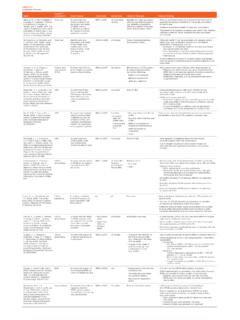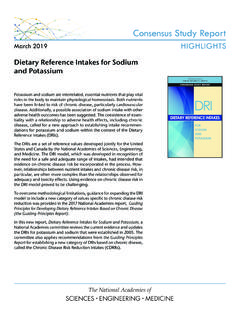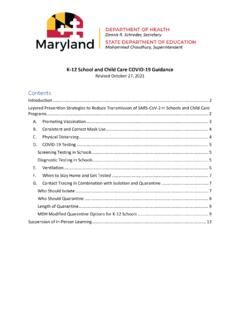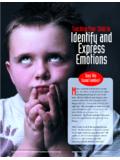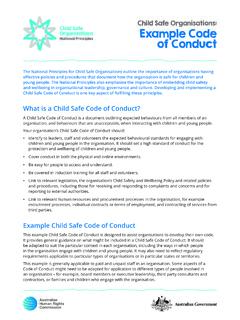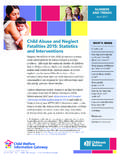Transcription of Child Development and Early Learning: A Foundation for ...
1 Transforming the Workforce for Children Birth Through Age 8: A Unifying Foundation Young children thrive when they have secure, positive relationships with adults who are knowledgeable about how to support their Development and learning. The science of Child Development and Early learning makes clear the importance and complexity of working with young children from infancy through the Early elementary years. Research during the past decade has revealed much about how children learn and develop. Studies have shown that Early childhood is a time when developmental changes are happening that can have profound and lasting consequences for a Child s future.
2 While people have long debated whether nature or nurture plays the stronger role in Child Development , recent studies reveal the importance of how the two influence each other as a Child develops: what a Child experiences and is exposed to interacts with his or her underlying biological makeup. Research has also shown that much more is going on cognitively, socially, and emotionally in young children including infants than scientists or care and education professionals previously knew. Even in their earliest years, children are starting to learn about their world in sophisticated ways that are not always reflected in their outward behavior.
3 Learning and Development for young children is both rapid and cumulative, continuously laying a Foundation for later and related insights emerging from research have strong implications for settings where young children are cared for and educated. This booklet provides an overview of this research and its implications for what educators and other adults who work with children need to know and be able to do in order to best support children s healthy Development . Children are already learning at birth, and they develop and learn at a rapid pace in their Early years.
4 This provides a critical Foundation for lifelong progress, and the adults who provide for the care and education of children from birth through age 8 bear a great responsibility for their health, Development , and learning. Transforming the Workforce for Children Birth Through Age 8, a 2015 report from the Institute of Medicine and National Research Council, explores the implications of the science of Child develop-ment for the professionals who work with these children. Child Development and Early Learning: A Foundation for Professional Knowledge and Competencies2 TRANSFORMING THE WORKFORCE FOR CHILDREN BIRTH THROUGH AGE 8: A UNIFYING FOUNDATIONThe Biology of Early Child DevelopmentResearch in developmental biology and neuroscience offers four broad insights about the role of the developing brain and other biological systems in Early childhood Development : The developmental window (rapidity of brain Development during Early Child -hood).
5 The brain develops through a dynamic interaction between underlying biologi-cal processes and exposures and experiences in the environment. This process begins at conception and continues throughout life. During a Child s Early years, the brain develops in rapid and fundamental ways, and connections among neurons are rein-forced. Because of this, Early childhood is a window of both great risk of vulnerability to disruption and great potential for the impact of positive developmental influences. The interplay of genes and environment. In many or even most cases, the causes of healthy, normal Development as well as disease, disorders, and developmental problems are best viewed as an interplay between genes and environment.
6 While a Child s genetic makeup has an influence on how strongly he or she is affected by some environmental factors or experiences, emerging research also shows that influences in the environment can shape whether genes are turned off or on. Neither environment nor biology alone is destiny. The impact of stress on Development . There is now strong evidence that Early psy-chological and social adversities beginning even during fetal Development can have important short- and long-term effects on the brain s Development and the way the brain and body handle stress. In addition to the brain, multiple systems are involved in the response to stress and can be affected by chronic adversity, including the immune system and the endocrine system.
7 While enriching experiences in the Early years will support healthy brain Development , disturbances or deficiencies before birth or in ear-ly childhood can interrupt or alter the growing brain, resulting in changes that range from subtle incapacities to generalized developmental disabilities. Examples of serious stressors faced by many children include abuse or neglect, the death of a parent, food insufficiency, housing instability, a parent living with mental illness, or exposure to conflict or violence in the home or neighborhood. Although children at any socioeconomic level can experience stressors, children in marginalized populations or who experience chronic economic adversity face a disproportionate risk of experiencing a confluence of multiple sources of chronic stress.
8 Individual differences in sensitivity to environments. There are substantial individu-al differences in how susceptible children are to influences in their environment. Some individuals seem more sensitive to both positive and negative influences; others sur-vive challenging environments and seem to thrive with little detrimental effect. Together, these four broad insights have reshaped understanding of the formative experiences of children in their families, communities, health care settings, childcare and preschool centers, and schools. These insights also have implications for those who educate and care for young children and they make clear the complexity and importance of this role.
9 Child Development AND Early LEARNING: A Foundation FOR PROFESSIONAL KNOWLEDGE AND COMPETENCIES 3 Together with the research in developmental biology and neuroscience, research in developmental, cog-nitive, and educational psychology has contributed to a greater understanding of the developing Child . The picture that has emerged is remarkably complex and reveals that many aspects of Development and learning are interrelated. For example, a Child relies on developing an ability to regulate emotions and attention in order to concentrate and stay engaged long enough to learn new ideas and skills.
10 Similarly, while certain skills and concepts are distinct to particular subject areas, learning in these subject areas also relates to general cognitive skills such as reasoning, attention, and memory. Learning is also in-fluenced by a Child s developing relationships with adults and peers. A Child s security both physically and in relationships creates the context in which learning is achievable. Physical health matters as well; studies have linked food insecurity among children and their families to poor academic outcomes, for example, while increased physical activity has been linked to improved academic performance.





